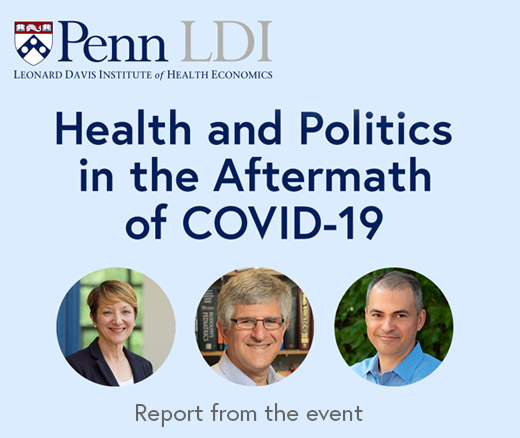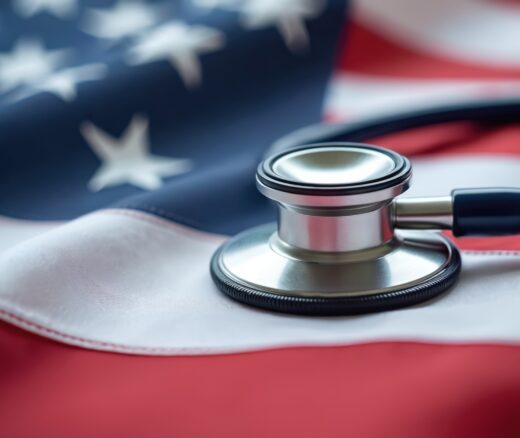
Contradictions That Confuse Federal Food Policies
Announcing Bold New Goals While Crippling the Infrastructure Needed to Achieve Them
Population Health
In Their Own Words

Every year, from January through mid-April, the glass-lined lobby of the Karabots Pediatric Care Center in West Philadelphia gets transformed by volunteers helping people file taxes and understand their returns.
A typical shift finds a first-time filer getting coached through each line of the family’s tax return. The mother of a clinic patient learns she can claim expenses from her daughter’s college education, while an elderly woman who already filed her taxes sets a time to apply for the Pennsylvania Rent Rebate program.
These services are offered by the Medical Financial Partnership (MFP) at Children’s Hospital of Philadelphia (CHOP, which engages volunteers to provide free tax prep to employees, community members, parents, and teenage patients working their first jobs.

MFP, directed by LDI Senior Fellow George Dalembert, MD, MSHP, is grounded in research showing that a family’s wealth is linked to its health. By making certain financial choices, families and others with limited resources can pursue educational opportunities and achieve financial stability—raising the odds for better health.
Since 2019, MFP has partnered with Campaign for Working Families, Inc. (CWF) to conduct free tax prep on-site at CHOP Karabots at 48th and Market Streets. During the 2024 tax season, our CHOP Karabots team prepared 383 returns and got $520,510 into the hands of taxpayers through federal and state returns. The average refund was $1,957.
Filing taxes can be intimidating because tax law is complex. Many people are suspicious of federal programs, leading some individuals or families to forgo filing.
But taking advantage of tax credits—a proven tool to ease poverty—requires that individuals file taxes. About 20% of those eligible for the Earned Income Tax Credit (EITC) fail to claim it each year, resulting in $7 billion of unclaimed benefits annually.
During the 2024 tax season, our team addressed an often-intimidating process by distilling tax education into waiting room materials. We selected tax literacy topics by surveying Karabots taxpayers and creating materials for the five most common areas of uncertainty: 1) withholding, 2) education credits, 3) Child Tax Credit (CTC), 4) Earned Income Tax Credit (EITC, and 5) selecting a standard deduction versus itemizing.


When taxpayers completed their intake, volunteers handed them a copy of literacy materials. Taxpayers then waited as volunteers prepared their return. When the return was ready, taxpayers were called back to review their returns.
We surveyed 40 taxpayers at the end of their visit and found that 46% of respondents read the waiting room materials. Of those who reviewed them, 95% found the materials to be “helpful” or “very helpful.”
For respondents, the most impactful information was about tax withholding (34%); going through the return line-by-line (32%); tax credits (9.7%); and the difference between standard deductions and itemizing (9.7%).
The intervention’s impact was limited because fewer than half of taxpayers reviewed the materials while waiting for their return to be prepared. The educational content was valuable for those who reviewed the documents, and most taxpayers left their appointment with no questions.

We will explore why some respondents did not review the materials. Potential barriers may include lacking time (e.g., caring for a child while waiting, replying to a coworker’s request to cover their shift, or learning which bus to take home), the materials being at too high of a reading level, and a lack of interest in taxes or the print modality of learning about the topics.
One possible future approach comes from Anya Jayanthi, a Penn undergraduate who found an innovative way to present educational materials to taxpayers in her accounting class, Tax Policy and Practice in the Philadelphia Community, taught by Professor Edward Scott, CPA, PhD.
The course is an Academically Based Community Service (ABCS) course supported by the Netter Center for Community Partnerships that integrates lectures on the American tax system and the racial wealth gap with student community service as tax preparer volunteers.
As part of the collaboration, Jayanthi created videos that present the material from MFP’s tax literacy pilot in an animated format. These short videos covered why filing can help taxpayers. It also explained filing statuses, withholding, tax credits, and selecting the standard deduction versus itemizing expenses. MFP plans to roll out the educational videos to taxpayers this tax season and evaluate their effectiveness.
[See video here.]
It is essential to meet patients where they are and recognize the constraints on their time, from caregiving to commuting. A busy mom coming for tax prep—between picking up her child from daycare and starting a night shift—– might lack the capacity to read five sheets on taxes. But a 90-second video on the waiting room television may prompt her to ask her tax preparer a follow-up question that helps improve her finances. Content like Jayanthi’s videos should target issues that patients and families care about the most, not what a hospital believes is the most helpful.
During the 2025 tax season, MFP will again use waiting room time to get taxpayers and families to engage with financial wellness services. Through a partnership with Clarifi, taxpayers can receive free financial counseling and learn about their credit score. Patient Resource Navigators will screen interested taxpayers to determine eligibility for 11 different public benefits. MFP also aims to engage more adolescents in tax prep by promoting those services to working teenagers and encouraging teen patients to file their taxes.
Initiatives like MFP and the tax literacy pilot are not enough to reach financial prosperity. They must be paired with long-term social policy change and an overhaul of financial systems that prevent upward mobility. Policies such as eliminating bias in property appraisals and increasing taxes paid by the ultra-wealthy can help bridge the racial wealth divide. By recognizing the role of poverty in determining health outcomes and building wealth, we can improve our patients’ chances for a longer and healthier life.




Announcing Bold New Goals While Crippling the Infrastructure Needed to Achieve Them

Promising New Evidence and What’s Next

From 1990 to 2019, Black Life Expectancy Rose Most in Major Metros and the Northeast—but Gains Stalled or Reversed in Rural Areas and the Midwest, Especially for Younger Adults

A Penn LDI Seminar Focuses on Why They’re Important for the Future

Former Philadelphia Health Commissioner Warns That Gutting the CDC, Undermining Vaccines, and Politicizing Science Will Leave the U.S. Dangerously Unprepared for the Next Pandemic

Rural Parents Had More Emergency Visits and Insurance Loss Than Urban Peers, an LDI Study Shows. Integrated Baby Visits Could Help All Parents Be Healthier